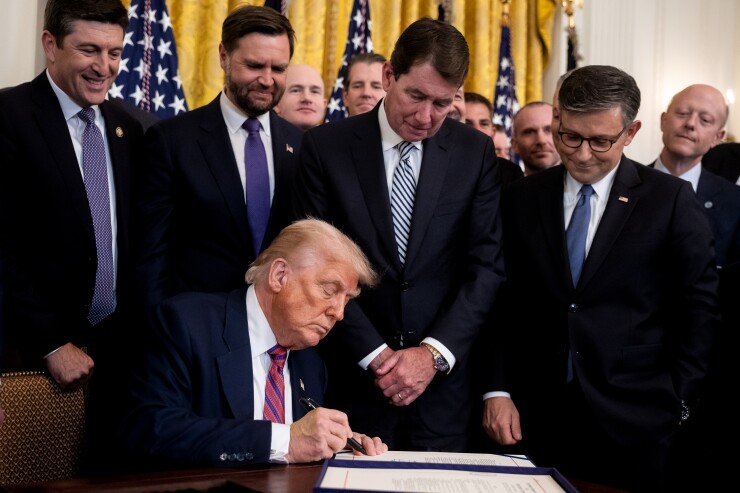
WASHINGTON — Now that President Donald Trump has
The stablecoin bill poses both
Some large institutions have signaled that they will enter the market in one form or another, lured by the possibility of providing banking services to the growing, profitable industry, or by issuing their own coin.
"I think people are excited that there's now a pretty robust and durable regulatory framework for stablecoins," said Mike Nonaka, a partner at Covington & Burling. "If you're a bank, or if you're a nonbank company and you're interested in issuing stablecoin, there's a regulatory framework for which there aren't questions about permissability, and I think that stability can be very invigorating for technology."
But bankers fell far short on their wish list of items in the stablecoin bill. The GENIUS Act didn't include a blanket prohibition on stablecoin issuers receiving Federal Reserve master accounts, or in barring stablecoin issuers from offering yield-like products. Small banks in particular fear that the widespread adoption of stablecoins could
Now that the stablecoin bill is law, much of this discussion and debate will fall to the regulators, who are now tasked with a laundry list of rules to write. The most important of those is how nonbank issuers can engage on stablecoin, an area where the legislation gave a lot of leeway to both the Treasury Department and state regulators to work out amongst themselves.
"The issues on which we're more focused with our banking clients are really the rules that will be forthcoming about how the nonbank issuers can engage on stablecoin," said Karen Petrou, co-founder of Federal Financial Analytics. "There certainly is the question of the extent to which a bank holding company or an insurance or subsidiary of an IDI could engage in stablecoins. But the bigger issue from most of our clients is what the marketplace is likely to look like and who's coming at them."
The Fed is also responsible for a key piece. The stablecoin bill says that master account status for nonbank payment stablecoins maintains the status quo, not explicitly banning nonbanks from access.
"Arguably, the Fed has the authority to open master accounts," Petrou said. "Now, that's what the stablecoin issuers believe. Banks say no, and the status quo says 'back over to you, Fed — you decide."
Currently, the Fed has a policy statement that dictates which firms can and can't receive master accounts, Nonaka said. That policy statement could change to either more easily allow nonbank issuers or to prohibit them altogether.
"The Federal Reserve has a policy statement that tells you how it evaluates requests for Master accounts and Fed payment services, and that policy statement doesn't preclude stablecoin issuers from gaining such access," he said.
Banks themselves who are interested in the stablecoin business also have a host of legal issues to sort through with the legislation.
"Banks will be looking to their federal regulator for regulations, and banks will have to decide what structure they'd like to use for issuing stablecoins," Nonaka said. "You know, will it be a subsidiary of the insured depository institution? Will it be another entity? Where exactly do we locate a stablecoin issuer within our corporate structure?"
The yield issue for regulators is tricker. It could be down to individual regulators, the states or the Treasury Department to make their own rules related to what kind of yield-like products — like staking, or rewards on other offerings in exchange for holding the stablecoin — a stablecoin could offer.
That issue might also be addressed in the forthcoming market structure legislation, said Christopher Boone, a partner at Venable LLP. The version of market structure legislation that passed in the House is called the CLARITY Act, which is now going before the Senate for consideration.
"Amendments to GENIUS can directly be made," he said. "And the CLARITY Act might be one of the vehicles for making amendments, although whether those will address the specific pain points is unclear. Yield in particular is a tough issue."
While the stablecoin bill passed relatively quickly in Congressional terms, there's reason to believe that the market structure bill will take a bit longer. The GENIUS Act was passed "cleanly" by the House, meaning they did not make substantial changes from the Senate version. That circumvented a contentious and lengthy process known as reconciliation for that legislation.
Senate Banking Committee Chairman Tim Scott, R-S.C., on Tuesday released a "discussion draft" of a bill and initiated a request for information process, which could mean that the Senate could be gearing up to pass its own version of the market structure bill rather than taking up the House-passed version.
For this issue and many others, banks and nonbank potential issuers are still in the position of building a product or offering at the same time the rules are being written, Boone said.
"The kind of where-rubber-meets-the-road issues, we just don't know what the guidelines will be yet," Boone said. "We are basically driving on a road as it's being built, so to speak."






